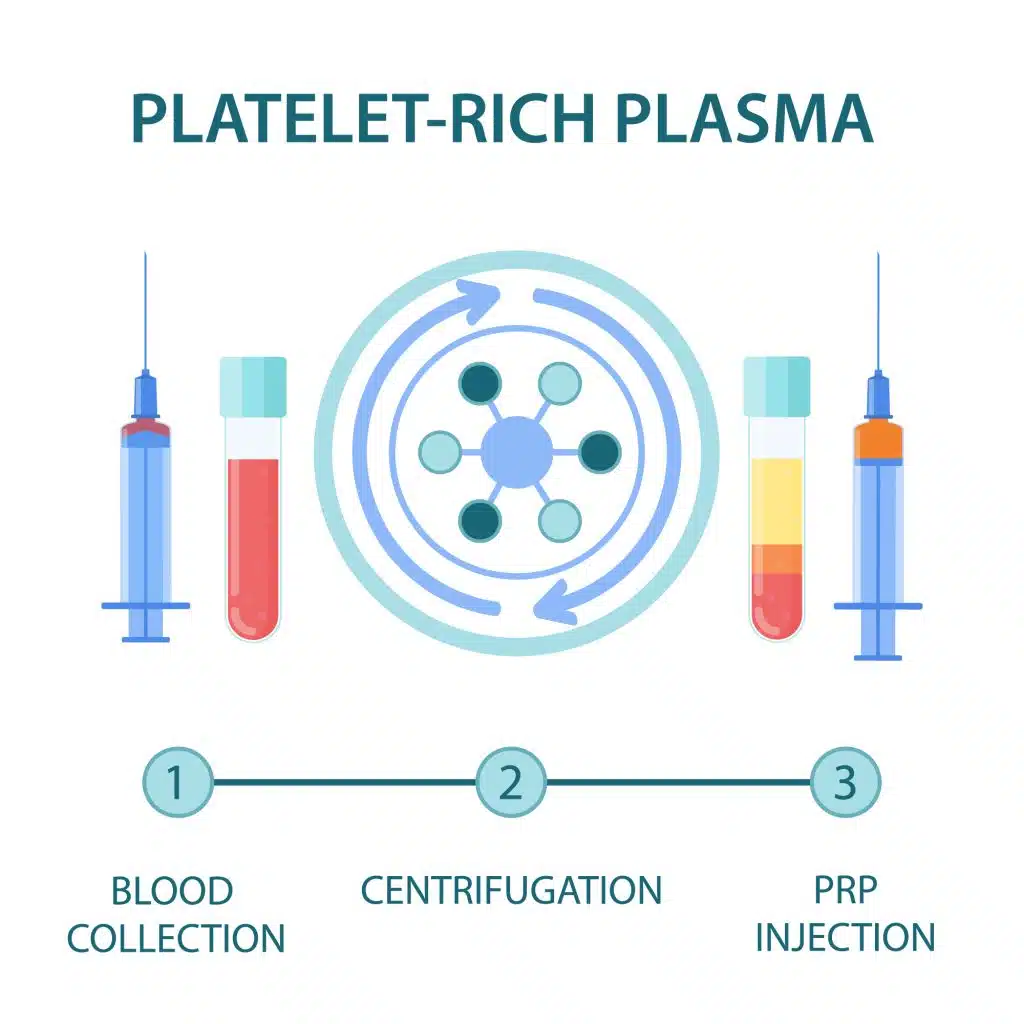Platelet Rich Plasma PRP Injections Near Me
In recent years, doctors have learned that the body has the ability to heal itself. Platelet-rich plasma therapy is a form of regenerative medicine that can harness those abilities and amplify the natural growth factors your body uses to heal tissue.
The following explains what is currently known about how PRP solution is made and components of the formula.

How Is Platelet-Rich Plasma (PRP Injection) Made?
- Red blood cells, approximately 45% of blood, are forced to the bottom of the vial.
- White blood cells and platelets form a thin middle layer, called a buffy coat, which comprises less than 1% of the centrifuged blood.
- “Platelet-poor” plasma, or plasma with a low concentration of platelets, makes up the remaining top layer, about 55% of the centrifuged blood sample.
Once the centrifuge process is complete the doctor or medical technician will remove the vial from the centrifuge and prepare the PRP solution for injection.
Centrifugation speed and time can vary. Differences in centrifugation speed and time affect the composition of PRP. There is no clear consensus on what centrifugation process produces the best results for treating osteoarthritis.

What Is in a Platelet-Rich Plasma Injection?
All PRP injections are not the same. The exact make-up of platelet-rich plasma depends on several variables, including the concentration of platelets, the concentration of white blood cells, and the use of additives.
Concentration of platelets
Normal blood has 150,000 to 450,000 platelets per microliter (μL), and the concentration of platelets in platelet-rich plasma can vary from 2.5 to 9 times that.1 Concentration levels depend on the individual’s blood, how much blood was drawn, the centrifuge process (e.g., rotation speed and duration), and other clinical preparation methods.
While it may seem logical that plasma with the highest possible platelet concentration will get better results than plasma with a lower platelet concentration, that is not necessarily the case. One lab study suggested that plasma with concentrations 2.5 times that of normal blood was ideal, and higher concentrations might actually limit new cell growth.2 More research is needed in this area.
White blood cell count
The immune system depends on white blood cells to fight infection, but the cells’ role in PRP therapy is unclear. Some experts suspect that white blood cells inhibit tissues’ ability to heal, perhaps promoting inflammation, scar tissue, and damage to nearby tissues.3 Other experts think that, while white blood cells may not aid tissue healing, they have no negative effects, or may have beneficial effects.
As with the concentration of platelets, the concentration of white blood cells is determined by an individual’s blood as well as clinical preparation methods.
AdditivesSome doctors mix additives into the platelet-rich plasma. These additives, called thrombin and calcium chloride, artificially activate the platelets, stimulate clotting, and may enhance platelet-rich plasma’s regenerative properties.
Future research may show that the preparation and composition of platelet-rich plasma should be tailored for specific medical conditions. For example, one “recipe” may be best suited for treating osteoarthritis while another is optimal for treating tendonitis.
Until guidelines are established, variations in PRP preparation are up to the individual doctor.
Classifying PRP formulas
Because the preparation and ingredients of PRP injections are so variable, it is difficult to evaluate PRP’s efficacy. To that end, some scientists have called for a classification system to distinguish between various formulations of platelet-rich plasma.4 Such a system could help researchers figure out whether these differences matter and, if so, what preparation and formulation of platelet-rich plasma works best.
The information provided in this blog is for general informational and educational purposes, and should not be considered medical advice for any individual problem you may have. This information is not a substitute for the professional judgment of a qualified health care provider who is familiar with the unique facts about your condition and medical history. You should always consult your health care provider prior to starting any new treatment, or terminating or changing any ongoing treatment. Please contact us if we can be helpful in answering any questions or to arrange for a visit or consult.
- 1.ECRI Institute. AHRQ Healthcare Horizon Scanning System Potential High Impact Interventions: Priority Area 01: Arthritis and Nontraumatic Joint Disease. (Prepared by ECRI Institute under Contract No. HHSA290201000006C.) Rockville, MD: Agency for Healthcare Research and Quality. June 2013. effectivehealthcare.ahrq.gov.
- 2.Graziani F, Ivanovski S, Cei S, Ducci F, Tonetti M, Gabriele M. The in vitro effect of different PRP concentrations on osteoblasts and fibroblasts. Clin Oral Implants Res. 2006 Apr;17(2):212-9. PubMed PMID: 16584418.
- 3.Taralyn M. McCarrel, Tom Minas, Lisa A. Fortier; Optimization of Leukocyte Concentration in Platelet-Rich Plasma for the Treatment of Tendinopathy. The Journal of Bone & Joint Surgery. 2012 Oct;94(19):e143 1-8.
- 4.Dohan Ehrenfest DM, Bielecki T, Mishra A, Borzini P, Inchingolo F, Sammartino G, Rasmusson L, Evert PA. In search of a consensus terminology in the field of platelet concentrates for surgical use: platelet-rich plasma (PRP), platelet-rich fibrin (PRF), fibrin gel polymerization and leukocytes. Curr Pharm Biotechnol. 2012 Jun;13(7):1131-7. Review. PubMed PMID: 21740379.



